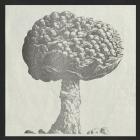Concern around nuclear technology triggered a new phase in the modern Australian environmental movement. In the 1970s, there was an explosion of protest across Queensland, as growing awareness of the impacts of uranium mining and nuclear testing galvanized public concern into action. Local Friends of the Earth (FoE) groups, the Movement Against Uranium Mining (MAUM), Campaign Against Nuclear Energy (CANE), and the Uranium Moratorium all produced hundreds of flyers, pamphlets, reports, and broadsheets presenting their arguments against nuclear power, mines, and bombs.
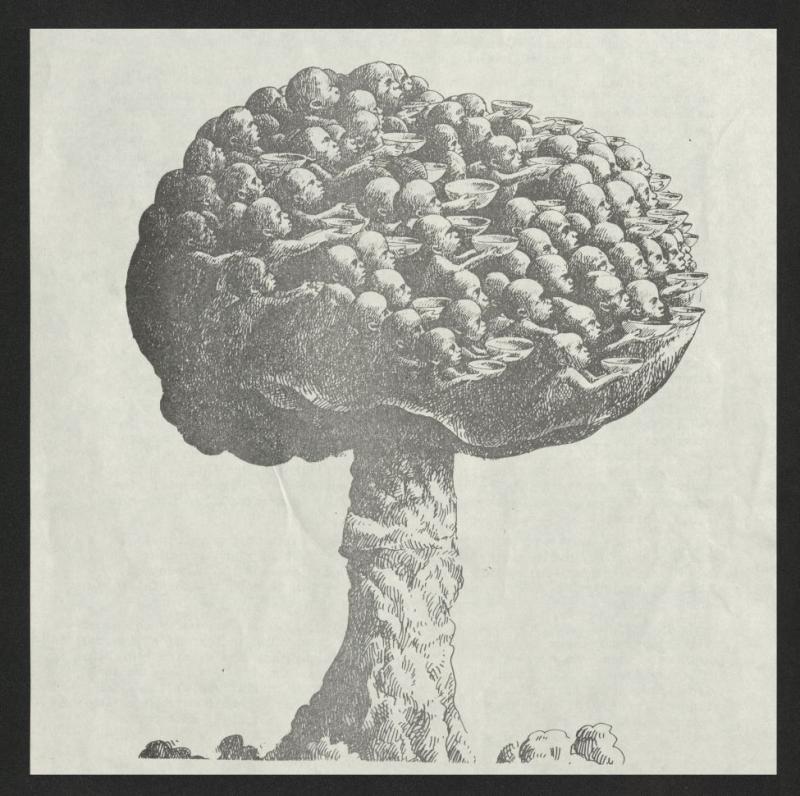
Fig. 1. Anti-uranium Action Group flyer, “An Invitation to People Who Are Serious about Stopping Nuclear War,” date unknown. This flyer conveys fear of nuclear technology’s impact on humanity but little about its effects on nature.
Fig. 1. Anti-uranium Action Group flyer, “An Invitation to People Who Are Serious about Stopping Nuclear War,” date unknown. This flyer conveys fear of nuclear technology’s impact on humanity but little about its effects on nature.
Anti-uranium Action Group Ephemera FVF48 A57.2. 61UQ_ATOM, Fryer Library, the University of Queensland Library. Courtesy of Fryer Library, the University of Queensland Library.
The copyright holder reserves, or holds for their own use, all the rights provided by copyright law, such as distribution, performance, and creation of derivative works.
However, despite the antinuclear movement’s foundational role in the development of Australia’s modern environmental movement, it is unclear whether environmentalists’ fears of a nuclear apocalypse reflected concerns about nature’s intrinsic value (Figure 1). Past environmentalism had sought to preserve nature for scenic, recreational, or resource-extraction purposes. Drawing on antinuclear-movement ephemera held at Fryer Library at the University of Queensland, this article explores whether fears of nuclear catastrophe changed this perspective. These materials present images of mutated children, starving communities, and circles of radioactive fallout (Figure 2), which viscerally sought to make an unthinkable future real. Those seeking to avert this future used three arguments, which still resonate today: erosion of the rights of protesters, workers, and First Nations peoples; profiteering and power grabbing by the nuclear industry; and harms to human health. In these framings nature played an indirect role as a victim of nuclear apocalypse.
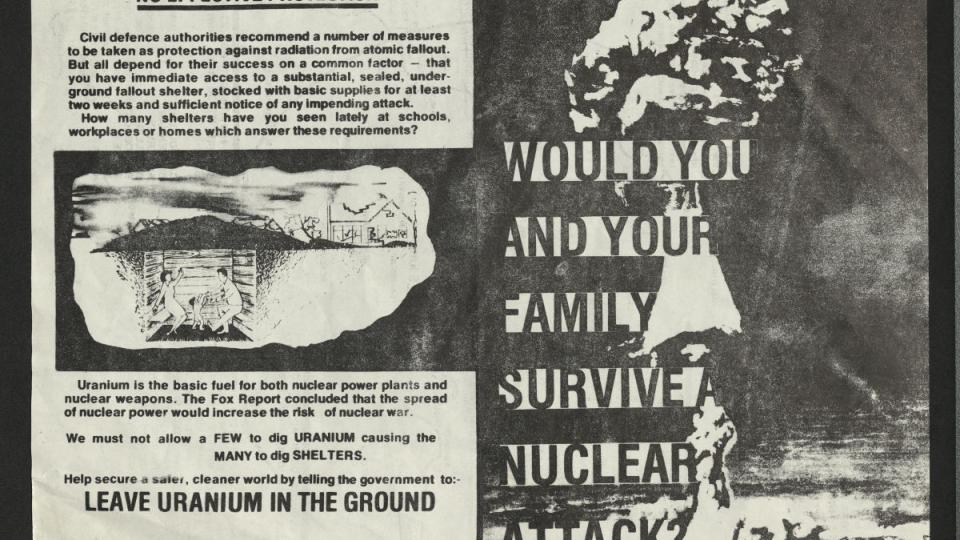
Fig. 2. Campaign Against Nuclear Power flyer (side 1), “Would You and Your Family Survive a Nuclear Attack?,” date unknown.
Fig. 2. Campaign Against Nuclear Power flyer (side 1), “Would You and Your Family Survive a Nuclear Attack?,” date unknown.
Campaign Against Nuclear Power (Brisbane, Qld) Ephemera, 61UQ_ATOM, FVF99 C8.9, Fryer Library, the University of Queensland Library. Courtesy of Fryer Library, the University of Queensland Library.
The copyright holder reserves, or holds for their own use, all the rights provided by copyright law, such as distribution, performance, and creation of derivative works.
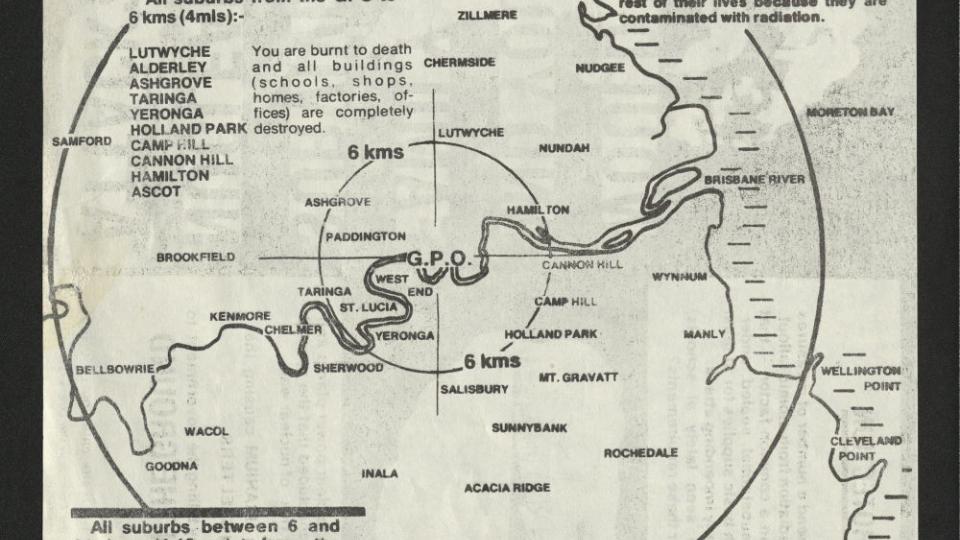
Fig. 2. Campaign Against Nuclear Power flyer (side 2), “Would You and Your Family Survive a Nuclear Attack?,” date unknown. This double-sided A5-size flyer showed how the city of Brisbane would be devastated in a nuclear attack, while noting the lack of any protection—such as shelters, contemporaneously available across the region.
Fig. 2. Campaign Against Nuclear Power flyer (side 2), “Would You and Your Family Survive a Nuclear Attack?,” date unknown. This double-sided A5-size flyer showed how the city of Brisbane would be devastated in a nuclear attack, while noting the lack of any protection—such as shelters, contemporaneously available across the region.
Campaign Against Nuclear Power (Brisbane, Qld) Ephemera, 61UQ_ATOM, FVF99 C8.9, Fryer Library, the University of Queensland Library. Courtesy of Fryer Library, the University of Queensland Library.
The copyright holder reserves, or holds for their own use, all the rights provided by copyright law, such as distribution, performance, and creation of derivative works.
By 1978, protesters’ and workers’ rights were being persistently attacked in Queensland. The spread of antinuclear sentiment coincided with the institutionalized suppression of civil rights during the era of hard-line Premier Joh Bjelke-Peterson (Queensland Premier, 1968–1987), nicknamed “The Hillbilly Dictator.” He was known for supporting the use of force against protesters and the suppression of trade unions, and was said to have turned Queensland into a police state riddled with corruption. Bjelke-Peterson’s pro-uranium stance was matched at the federal level by Prime Minister Malcolm Fraser until 1983, as well as by his successor, Prime Minister Bob Hawke, who broke Labor’s “no new mines” pledge. Building on the wider alternative and protest movements and culture of the 1970s, Queensland antinuclear groups consistently highlighted the erosion of civil liberties in campaign materials (Figure 3). Combining multiple agendas, they used this argument as a call to arms to simultaneously stymie the nuclear industry and protect citizens’ rights (Figure 4).
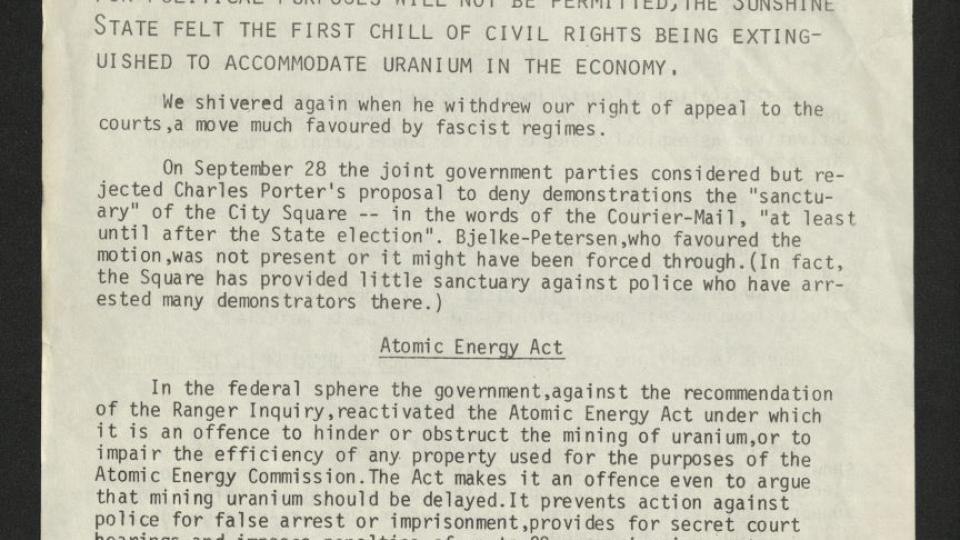
Fig. 3. Ecology & Resources Group, Communist Party of Australia flyer, “The Price of Uranium—Civil Liberty,” 22 October 1977. Premier Bjelke-Petersen’s agenda to implement a “police state” is connected to the uranium industry in this flyer.
Fig. 3. Ecology & Resources Group, Communist Party of Australia flyer, “The Price of Uranium—Civil Liberty,” 22 October 1977. Premier Bjelke-Petersen’s agenda to implement a “police state” is connected to the uranium industry in this flyer.
Ephemera relating to uranium and nuclear issues, 61UQ_ATOM, FV623 Folder 3 VF6, Fryer Library, the University of Queensland Library. Courtesy of Fryer Library, the University of Queensland Library.
The copyright holder reserves, or holds for their own use, all the rights provided by copyright law, such as distribution, performance, and creation of derivative works.
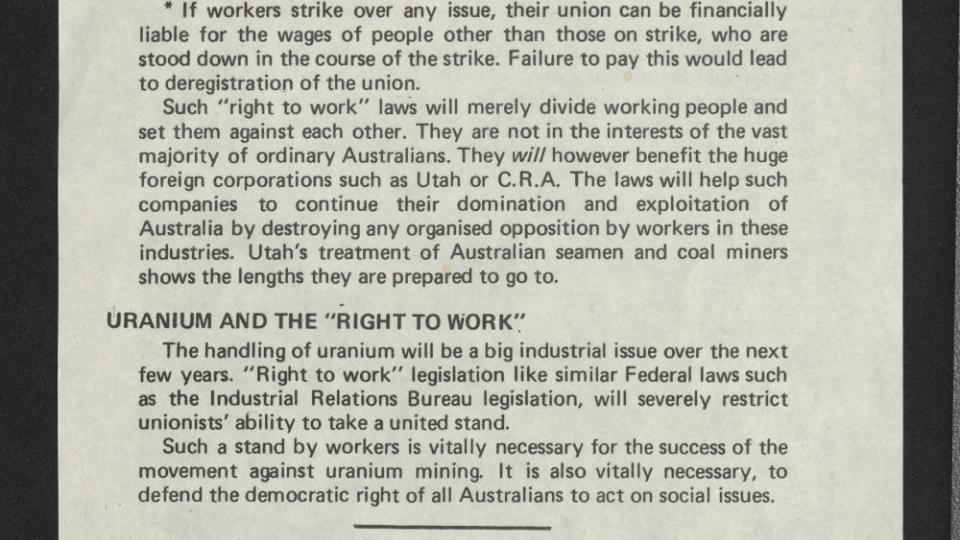
Fig. 4. Campaign Against Nuclear Power flyer, “Uranium: The Peoples Right to Decide” [sic]. Date unknown. This flyer highlights the connection between the uranium industry and proposed “Right to Work” laws in Queensland, which sought to suppress workers’ ability to organize.
Fig. 4. Campaign Against Nuclear Power flyer, “Uranium: The Peoples Right to Decide” [sic]. Date unknown. This flyer highlights the connection between the uranium industry and proposed “Right to Work” laws in Queensland, which sought to suppress workers’ ability to organize.
Campaign Against Nuclear Power (Brisbane, Qld) Ephemera FVF99 C8.2, 61UQ_ATOM, Fryer Library, the University of Queensland Library. Courtesy of Fryer Library, the University of Queensland Library.
The copyright holder reserves, or holds for their own use, all the rights provided by copyright law, such as distribution, performance, and creation of derivative works.
Campaign materials also consistently linked uranium mining to the erosion of First Nations culture and rights. Years of abuse had been swept under the carpet, with secret nuclear testing across Aboriginal lands of central and south Australia impacting Pitjantjatjara, Yankunytjatjara, Tjarutjam, Kokatha, Adnyamathanha, Dieri, and Kuyani people. By the 1970s, FoE was steadfastly calling out what they would later describe as “radioactive racism:” the trampling of First Nations culture, health, and rights by the uranium mining industry (Figure 5).
A second prevalent theme in movement material was distrust of perceived profiteering and power grabbing by the nuclear industry (Figure 6). Flyers highlighted the Harrisburg Three Mile Island partial meltdown disaster in Pennsylvania on 28 March 1979, arguing that plant management and “nuclear authorities” withheld information from residents and workers while lying to police and civil authorities. Other flyers provided extensive detail on the Browns Ferry (Alabama) near-meltdown incident of 22 March 1975, highlighting the multiple failures by plant managers.
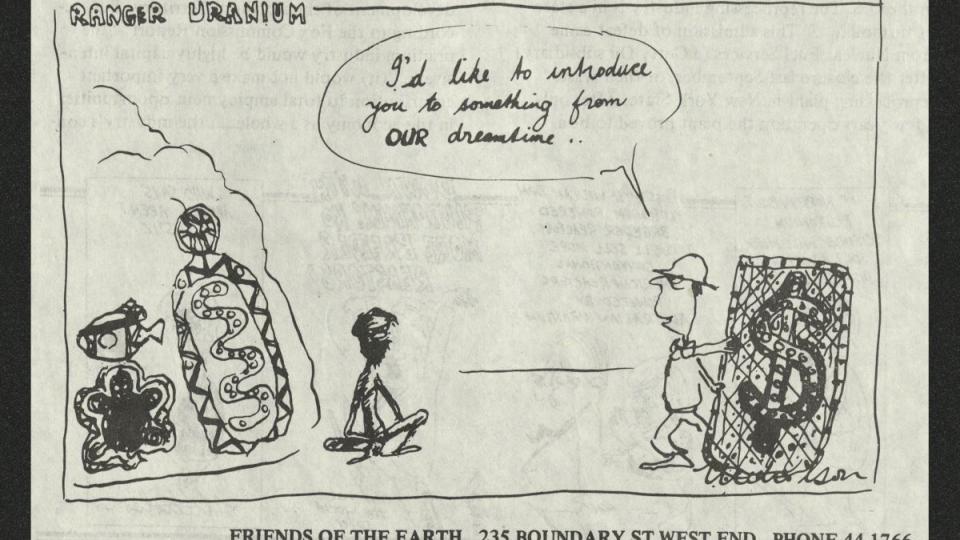
Fig. 5. Friends of the Earth flyer, “Ranger Uranium” (referring to Ranger Uranium mine in the Northern Territory), circa 1975. Friends of the Earth published this cartoon and others like it to highlight “radioactive racism” and nuclear colonialism: the imposition of the nuclear industry on Aboriginal lands despite widespread, persistent, and strong opposition.
Fig. 5. Friends of the Earth flyer, “Ranger Uranium” (referring to Ranger Uranium mine in the Northern Territory), circa 1975. Friends of the Earth published this cartoon and others like it to highlight “radioactive racism” and nuclear colonialism: the imposition of the nuclear industry on Aboriginal lands despite widespread, persistent, and strong opposition.
Friends of the Earth Ephemera, 61UQ_ATOM, FVF184 F7.5, Fryer Library, the University of Queensland Library. Courtesy of Fryer Library, the University of Queensland Library.
The copyright holder reserves, or holds for their own use, all the rights provided by copyright law, such as distribution, performance, and creation of derivative works.
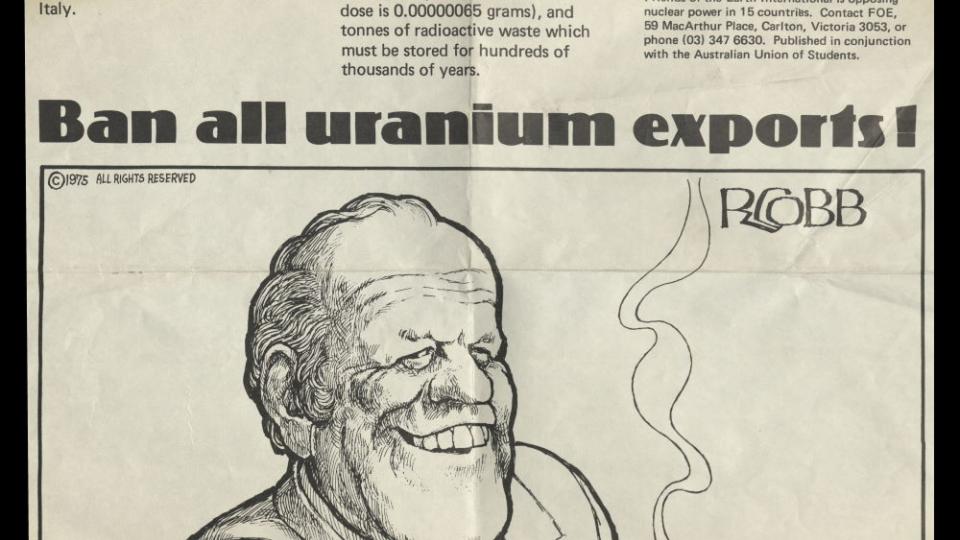
Fig. 6. R. Cobb, “Ban All Uranium Exports” in Friends of the Earth poster “Uranium: Who Profits?,” 1975. The sly smile of the nuclear baron is conveyed in this cartoon that dominates a large Friends of the Earth poster.
Fig. 6. R. Cobb, “Ban All Uranium Exports” in Friends of the Earth poster “Uranium: Who Profits?,” 1975. The sly smile of the nuclear baron is conveyed in this cartoon that dominates a large Friends of the Earth poster.
Friends of the Earth Ephemera, 61UQ_ATOM, FVF184 F7.1, Fryer Library, the University of Queensland Library. Courtesy of Fryer Library, the University of Queensland Library.
The copyright holder reserves, or holds for their own use, all the rights provided by copyright law, such as distribution, performance, and creation of derivative works.
It is the less prevalent third theme where concern around impacts on nature surfaced, linked most frequently to human health. Whether from “dirty bomb” fallout caused by illicit groups accessing the plutonium black market, radioactive annihilation caused by state-sponsored global nuclear war, or downstream effects of uranium-mining waste products, images of radioactive burns and two-headed children appeared across a multiplicity of campaign materials (Figure 7).
Signs that nature had an intrinsic value unconnected to human needs were conveyed primarily by FoE groups, who banded together under the umbrella of an “international environmental action network seeking to safeguard the Earth.” FoE’s A Slow Burn publication (issue 1, September 1974) argued that “the plutonium future must be rejected for what it is, an invitation to global ecological cataclysm.” The same year, an academic paper by John P. Holdren entitled “Radioactive Pollution of the Environment by the Nuclear Fuel Cycle” was reproduced, which linked uranium-mining waste at Jabiru to the death of aquatic plants and animals. Flyers noted how trace metals from uranium-mining waste products entered watercourses and polluted local water. Still, imagery and text most frequently linked these to risks to humans (Figures 7 and 8).

Fig. 7. Bayside Anti-Nuclear Group and Friends of the Earth flyer. “Be Sane! Be Cautious! Why Risk Having Two-Headed Children?,” circa 1979. This A5 hand-written flyer links the risk of nuclear technology to one’s grandchildren’s health by picturing a two-headed child.
Fig. 7. Bayside Anti-Nuclear Group and Friends of the Earth flyer. “Be Sane! Be Cautious! Why Risk Having Two-Headed Children?,” circa 1979. This A5 hand-written flyer links the risk of nuclear technology to one’s grandchildren’s health by picturing a two-headed child.
Friends of the Earth Ephemera, 61UQ_ATOM, FVF184 F7.2, Fryer Library, the University of Queensland Library. Courtesy of Fryer Library, the University of Queensland Library.
The copyright holder reserves, or holds for their own use, all the rights provided by copyright law, such as distribution, performance, and creation of derivative works.

Fig. 8. Campaign Against Nuclear Power broadsheet, “Uranium The World Says No,” 1978. This cartoon conveys how nuclear technology can affect other ecosystems, in a manner that links these ecosystem impacts back to human health.
Fig. 8. Campaign Against Nuclear Power broadsheet, “Uranium The World Says No,” 1978. This cartoon conveys how nuclear technology can affect other ecosystems, in a manner that links these ecosystem impacts back to human health.
Campaign Against Nuclear Power (Brisbane, Qld) Ephemera, FVF99 C8.15, 61UQ_ATOM, Fryer Library, the University of Queensland Library. Courtesy of Fryer Library, the University of Queensland Library.
The copyright holder reserves, or holds for their own use, all the rights provided by copyright law, such as distribution, performance, and creation of derivative works.
These materials suggest a degree of fear regarding nuclear technology’s impact on nature. However, by the 1970s, nature’s intrinsic value was yet to provide an independent rationale for challenging the nuclear industry. Perhaps the arguments against nuclear technology were so great, the salience of indiscriminate testing in neighboring Pacific islands so high, and the memories of nuclear terror in Hiroshima and Nagasaki in Japan so fresh, that arguments highlighting human risks were sufficient to underpin antinuclear agitation. Indeed, nuclear power stations were never built in Australia, Brisbane passed an antinuclear policy in 1983, and the siting of nuclear disposal repositories remains deeply contentious today. Thus, an enduring legacy of antinuclear activism may not only be the expression of defiance against the nuclear industry, but also the strengthening of a narrative connecting human survival to nature’s beneficence. In the nuclear age, we are no longer the true masters of our own fate. It is nature’s mercy on which we all depend.
PRIMARY SOURCES
- Friends of the Earth, A Slow Burn, no. 1 (September 1974).
- Holdren, John P. Radioactive Pollution of the Environment by the Nuclear Fuel Cycle. Melbourne: Friends of the Earth, 1974.
How to cite
Gulliver, Robyn. “Visions of a Nuclear Apocalypse: Notions of Nature in the 1970s Antinuclear Movement.” Environment & Society Portal, Arcadia (Summer 2023), no. 9. Rachel Carson Center for Environment and Society. doi:10.5282/rcc/9611.
ISSN 2199-3408
Environment & Society Portal, Arcadia
 This work is licensed under a Creative Commons Attribution 4.0 International License.
This work is licensed under a Creative Commons Attribution 4.0 International License.
2023 Robyn Gulliver
This refers only to the text and does not include any image rights.
Please click on an image to view its individual rights status.
- Adamson, Greg. “Stop Uranium Mining.” Australia’s Decade of Protest 1975–1985. Chippendale: Resistance Books, 1999.
- Hutton, Drew, and Libby Connors. History of the Australian Environment Movement. Cambridge: Cambridge University Press, 1999.
- Kearns, Barbara, ed. Stepping Out for Peace: History of CANE and PND (WA). Maylands: People for Nuclear Disarmament (WA), 2004.
- Martin, Brian. “Australian Anti-Uranium Movement.” Alternatives 10, no. 4 (1982): 26–35.
- Speck, Catherine. “Thunder Raining Poison: The Lineage of Protest Against Mid-Century British Nuclear Bomb Tests in Central Australia.” Australian and New Zealand Journal of Art 20, no. 1 (2020): 68–89.
- Tynan, Elizabeth. Atomic Thunder: The Maralinga Story. Sydney: NewSouth Publishing, 2016.
- Walker, Cam. Friends of the Earth Australia: 30 Years of Creative Resistance. Friends of the Earth Australia, n.d. https://commonslibrary.org/30-years-of-creative-resistance-2/.



